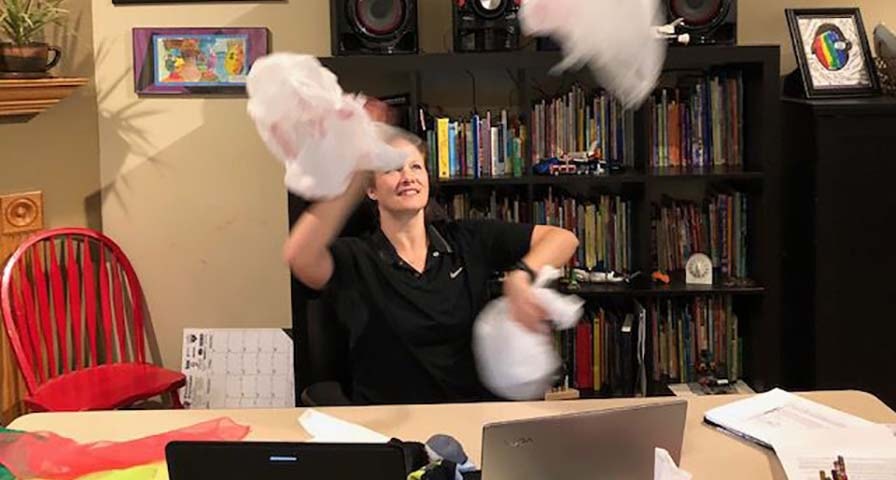Originally published May 29, 2020 by Hyde Park Herald.
By Aaron Gettinger
Classes in Art and Physical Education have continued at Hyde Park-Kenwood's public schools despite the challenges of remote learning.
Teachers from Shoesmith Elementary say their students have continued their work in both areas beyond the virtual classroom.
 PE teacher Jamie Schnall typically sees classes virtually once or twice a week, with appropriate instruction for each grade level. Schnall said she is teaching the same physical skills — balance, strength training, throwing, catching, aim, dribbling and more — as well as healthy eating and relaxation.
PE teacher Jamie Schnall typically sees classes virtually once or twice a week, with appropriate instruction for each grade level. Schnall said she is teaching the same physical skills — balance, strength training, throwing, catching, aim, dribbling and more — as well as healthy eating and relaxation.
"The curriculum is totally followed. It's just a little bit different than what most people would think phys. ed. should look like," she said. "Honestly, you just become very, very creative. You've got to keep in mind that the kids that we teach don't always don't have equipment or things available to them, so we really are creating things that we can use in their homes."
She taught a juggling unit early in the shutdown; mindful of the disastrous impact hard projectiles would have on vases and windows, her students used dish towels and stuffed animals. "It's really just about still teaching the curriculum and still having physical participation," she said. "We had some kids who wanted to use oranges, and I was like, 'No, sweetheart, we're not going to use fruit! That's a bad idea!'"
Schnall has been teaching using the online learning platform Nearpod, which allows the integration of online videos and free-response answer sections into lesson plans. Because of efforts to get computers with cameras to each student, she can watch her kids do yoga, push-ups and jumping jacks and correct their form in real time.
"I'm also praising the kids, because they're exercising at home," she said. "They'll find ways of doing things at home that I didn't even know was possible."
Sedentary living and restlessness being among the challenges of quarantined life, Schnall said parents and children alike have used her instruction and advice to get their blood pumping. Kids have looked up their own yoga routines; others have downloaded the application MapMyRun, taken their families out for a jog and then emailed Schnall their routes.
"This really gives them the ability to move and do things and really lighten it up and really help their mental health during this time," she said. "I think that physical education is probably the most vital subject that we can be learning right now in a pandemic, because these kids need this movement. They need it for their mind, body and soul, and I feel like having a quality physical education program during the pandemic is necessary."
Jennifer Teckchandani, who teaches art at Shoesmith, said art is also an important outlet for students during remote learning.
"I know teachers are also adding their own interactive lessons, but it's just so much sitting in front of a computer and answering questions and looking at screens," she said. "Art gives an opportunity to use the other half of your mind and use that creativity and individuality and be able to do something that expresses what you're doing, what you're feeling, what you're thinking, and to get a little bit more personal."
Teckchandani is pleasantly surprised at the number of students she is reaching. "Kids are coming in," she said. "They're showing me things that they're doing during their free time." She is teaching through video classrooms, one week with a recorded lesson and a live one the next week.
Inspired by "Caine's Arcade," a 2011 short documentary about a nine-year-old who made an arcade out of cardboard boxes in his father's auto parts store, Teckchandani taught her students to make their own arcade games. Parents and siblings played with them afterwards, a testament to the level of engagement with the arts going on at home.
A local middle school teacher recently told the Herald that remote learning (of literature) is difficult because students lack novels at home, and Teckchandani said she is actively looking for projects that either call for common materials or yield easily to modifications depending on individual circumstances. Dutch abstract artist Piet Mondrian limited himself to the primary colors, but Teckchandani was happy to let her students use purple, orange and green crayons when she taught his work.
In the interview, Teckchandani noted her students' active attempts to maintain community and support each other during the live lessons, and she expanded on the way the pandemic has affected their art in a subsequent email.
"They are not creating pieces with masks or empty streets, but the situation and the emotion is definitely part of their work," she wrote. "I see this in the artist's statements kids sometimes turn in with their work or their verbal statements as we share. They definitely do a lot of art that is about their favorite activities and favorite people or places, and share how much they miss these things.
"They are wondering when things will be back to normal so they can see those people again, or do those favorite things again. Many, during a self-portrait project we did, included things they loved in their work, then reflected on the objects or backgrounds they included (basketballs, playgrounds, favorite foods) and how much they miss the normal things we didn't think about."
"I think we've seen it's super important for the kids to have these outlets and these exercises in their lives, and they're really excited about doing it," she said. "I just want to stress that."
Seeking information about IHT's Online Physical Education program?




